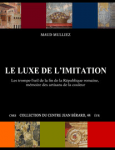| Type de document : | Ouvrage |
| Titre : | Le luxe de l’imitation |
| Auteurs : | Maud MULLIEZ, Directeur de publication |
| Editeur : | Naples : PUBLICATIONS DU CENTRE JEAN BERARD, 2020 |
| Collection : | Collection du Centre Jean Bérard |
| Langues | Français |
| Format : | 236 p. / Format numérique |
| ISBN/ISSN/EAN : | 978-2-38050-005-9 |
| Mots-clés : |
Géographique ITALIE ; ROMENom Commun ANTIQUITE ; HISTOIRE ; HISTOIRE DE L ART ; LUXE |
| En ligne : | https://books.openedition.org/pcjb/5827 |
| Résumé : |
L'art décoratif qui émerge à la fin de la République romaine sous la forme du trompe-l'œil architectural est fascinant par le niveau de technicité mis en œuvre pour représenter un espace tridimensionnel ; il frappe aussi par la richesse des couleurs et des matériaux feints distribués savamment à la surface des murs. La mimèsis y est une composante majeure : représenter l’architecture... certes, mais laquelle ? Inspirés à coup sûr de divers répertoires - décors de théâtre, édifices hellénistiques - les trompe-l'œil tardo-républicains puisent aussi dans l’univers sacré. En témoignent les marbres polychromes imités à profusion ainsi que la multiplication des matériaux précieux, bois rares, métaux brillants, ivoire, écaille de tortue, pierres précieuses, textiles lourds ou verre translucide qui contribuent aussi à conférer à ces décors une atmosphère de luxe et d'exotisme. Suivant qu'ils sont destinés à un public de clientes, d'amici ou à la sphère privée, ces décors semblent marqués par une série de différenciations tant sur le choix de la composition à plusieurs plans de profondeur ou au contraire limitée à un relief minimal, que sur le choix des matériaux représentés. Leur analyse permet donc d'entrevoir une cartographie des tendances et de leur signification, offrant un premier niveau de lecture sociale de ces peintures. La présence de traces matérielles qu'elles portent, incrustées dans l'enduit ou visibles à la surface de la couche picturale, en offre un second : des marques d'outils, de gestes et de procédés picturaux. ou encore la distinction de plusieurs mains pour la réalisation d'un même motif nous informent sur les méthodes et l'organisation des artisans à l'œuvre. C'est à l'analyse du langage imagé et du discours matériel de ces parois qu'est consacré ce livre. (Note de l'éditeur)
The decorative art that emerged at the end of the Roman Republic in the form of architectural trompe-l'oeil is fascinating because of the level of technicality used to represent a three-dimensional space; it is also striking because of the richness of the colours and feigned materials skilfully distributed on the surface of the walls. Mimesis is a major component: representing architecture... certainly, but which one? Inspired by various repertoires - theatre sets, Hellenistic buildings - the late-Republican trompe-l'oeil also drew on the sacred universe. The polychrome marbles imitated in profusion as well as the multiplication of precious materials, rare woods, shiny metals, ivory, tortoiseshell, precious stones, heavy textiles or translucent glass, which also contribute to conferring an atmosphere of luxury and exoticism on these decorations, are all evidence of this. Depending on whether they were intended for a public of clients, amici or the private sphere, these decorations seem to be marked by a series of differentiations, both in the choice of composition with several planes of depth or, on the contrary, limited to a minimal relief, and in the choice of the materials represented. Their analysis thus allows us to glimpse a cartography of trends and their significance, offering a first level of social reading of these paintings. The presence of material traces on them, embedded in the plaster or visible on the surface of the paint layer, offers a second level: marks of tools, gestures and pictorial processes, or the distinction of several hands for the realization of the same motif, inform us about the methods and organization of the craftsmen at work. This book is devoted to the analysis of the pictorial language and material discourse of these walls. (Editor's note) |
Bibliothèque de l'IFM
Se connecter
Adresse
Bibliothèque de l'IFMvotre adresse
votre code postal Ville
France
votre numéro de téléphone
contact













